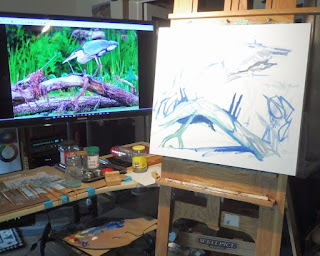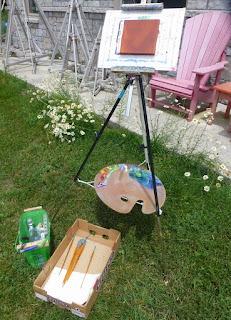 |
#2680 "Singleton Morning Cumulonimbus"
10x8 inches oil |
The sunrise heavy thunderstorm that delivered 14 mm of rain was on its way out to the east but it was going to be a very unstable day. The cold front and frontal wave would produce afternoon supercellular thunderstorms and damaging winds. We certainly lost some trees in the forest. We had a very large limb down on the lawn that I needed the tractor to move. The one stem of our shagbark hickory flexed and snapped the restraining cable that was designed to save the old and precious tree. Nature arrives all year long to feast on the nuts.
This is the view corresponding to #2681 "Castellanus in the Wake of the CB"" but looking toward the east at the sunrise thunderstorm that was exiting eastern Ontario.
 |
| Environment Canada Product |
My Brother had noticed a very scary graphic published by an on-line weather provider the day before. My answer to his questions was "only Environment Canada can issue warnings. The graphic looked terrifying and that was the provider trying be sensational and gather an audience. It was a summer cold frontal situation and yes, there was bound to be strong convection. The biggest threat was at the frontal wave and if the system occluded like this numerical guidance suggested, the threat was west to east along a line through Ottawa... " I have not included the scary on-line graphic. The Environment Canada Thunderstorm Outlook issued on the morning of June 16th, 2022 is to the left.
 |
| Sample Numerical Weather Guidance |
 |
| Water Vapour Image from the time of my painting |
This is the first in the sunrise series for Thursday June 16th, 2022 that include
#2680 "Singleton Morning Cumulonimbus",
#2681 "Castellanus in the Wake of the CB" and
#2682 "Morning Anvils and Congestus". My painting
#2663 "Singleton Calm After the Storm" deals with the image of the Derecho of May 21st, 2022.
The damage from June 16th, 2022 was not as severe as the derecho of May 21, 2022 but still extensive. Both affected the Quebec City-Windsor Corridor, Canada's most densely populated region. The May Derecho of 2022 ranked as the sixth costliest in Canada in terms of insurance claims.
From my days working with CANWARN and Environment Canada, we knew that it was only a matter of time before these and other storms would affect the area. An strong La Nina was still dominating the central Pacific and the impacts of that phenomenon reach out to affect Canada and indeed the Globe. Sahara dust storms and the Atlantic hurricane season are also strongly linked to La Nina. My performance measurement work from around 2000 revealed these correlations but it was outside my time and responsibility to pursue the science behind these linkages. My painting #2663 "Singleton Calm After the Storm" deals with the image of the Derecho of 2022.
For this and much more art, click on Pixels. Thank you.









































